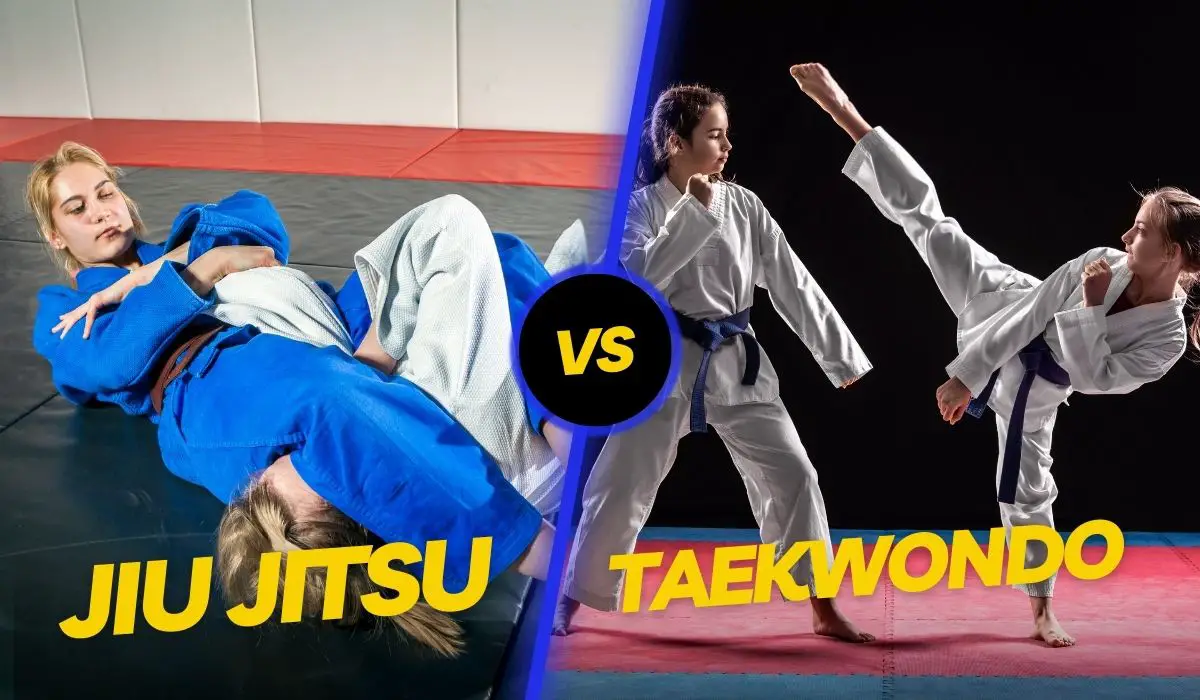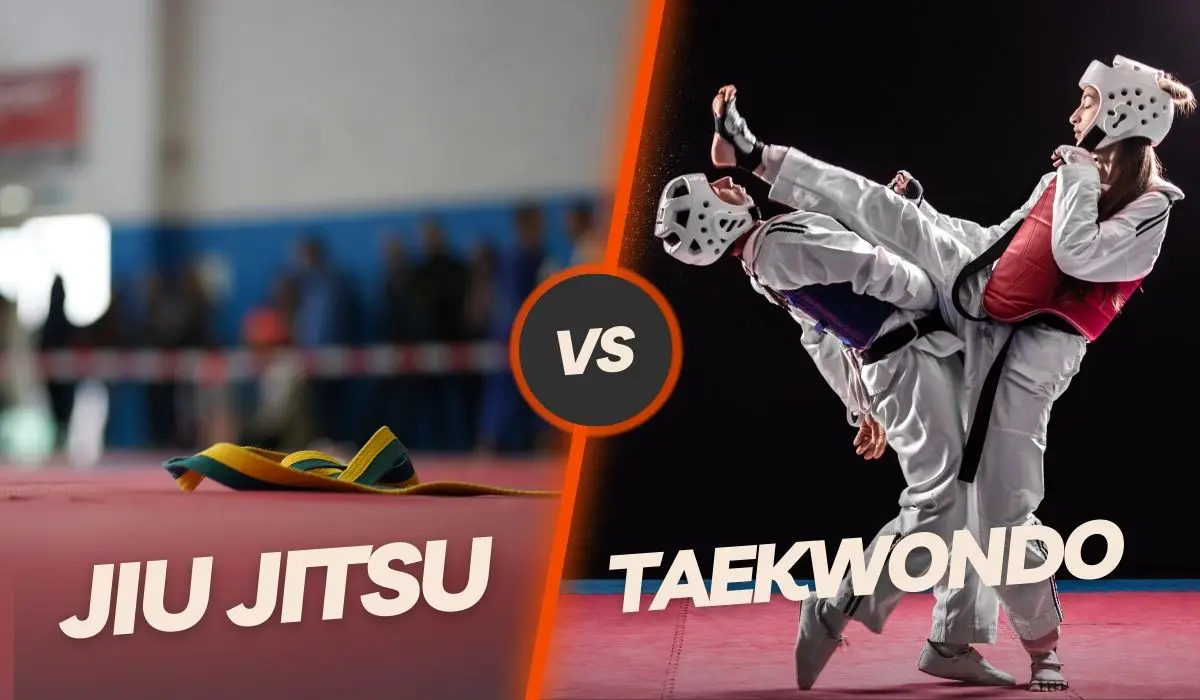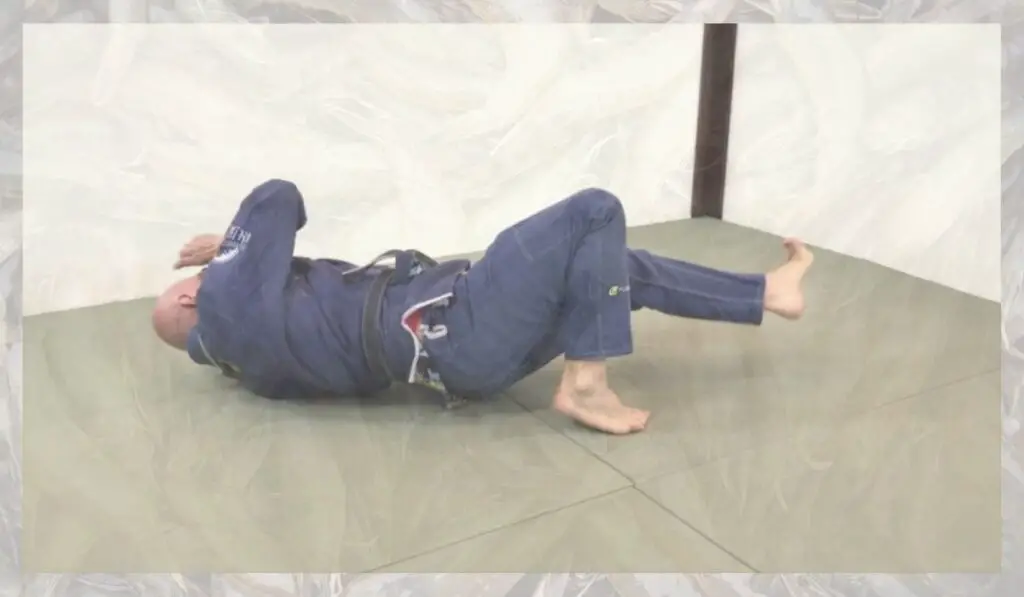Brazilian jiu-jitsu and Taekwondo are two excellent martial arts that provide several benefits. Practitioners, particularly children, love training in both combat systems, making it difficult to choose once. So, what exactly is the difference between Taekwondo and jiu-jitsu?
The main difference between jiu-jitsu and Taekwondo is that Taekwondo emphasizes standing striking techniques, whereas jiu-jitsu emphasizes ground combat. As a result, matches in the two disciplines differ, with Taekwondo granting points for strikes while jiu-jitsu is won primarily with submissions.
In the rest of the article, we’re going to look more in-depth at the differences between jiu-jitsu and Taekwondo. Therefore, we’ll go after their fighting styles, competition rules, status at the Olympics, presence in MMA, suitability for street fights, and respective popularities.
What Are the Differences in Fighting Styles Between Jiu-Jitsu and Taekwondo?

Taekwondo is a martial art that focuses on landing strikes. These strikes are often kicks, but the hands also play a crucial role in punching and defense. Taekwondo kicks, including the head and roundhouse kicks, will also be relatively high.
Brazilian jiu-jitsu doesn’t involve striking. Instead, it is focused on elements like ground fighting and clinching, winning by submission rather than landed blows.
This will often give jiu-jitsu the appearance of something closer to wrestling than to traditional martial arts like karate and kung fu.
What Are the Differences in Competition Rules Between Jiu-Jitsu and Taekwondo?

Because of the vastly different fighting styles, jiu-jitsu competitions are won differently from taekwondo spars. In Taekwondo, points are scored based on successful contacts because of their striking discipline.
Therefore, different numbers of points are won for different kinds of strikes. The highest-scoring strike is a kick to the head.
In a jiu-jitsu competition, a win is gained by either getting your opponent to submit or by them passing out. This is usually done by creating hyperextensions to joints that can be especially painful, leading to voluntary submission.
Alternatively, chokes can lead to submission or, if held long enough, cut off enough blood flow to the brain for the opponent to pass out.
Are Jiu-Jitsu and Taekwondo Olympic Sports?
Jiu-Jitsu is not an Olympic sport, and it has a few changes to make before it gets there. The International Olympic Committee requires the governing bodies of their sports not to be run for profit or by governments. BJJ still fails on both counts.
The good news is that new sports are added to the Summer Olympics every time new games occur, so there is a high chance that we could see jiu-jitsu in the Olympics shortly.
Unfortunately, the list of sports for the 2028 games has not yet been finalized, which is the earliest it could appear if the other criteria are met.
Aside from that, Taekwondo has been a full sport at every game since the 2000 Summer Olympics in Sydney, winning it a point in the jiu jitsu vs taekwondo debate.
Each game was played across 8 events, 4 for men and 4 for women, each in a different weight group. South Korea, the country the sport comes from, leads the medal table.
Before Taekwondo was a medal sport at the Olympics, it appeared as a demonstration sport in two games. The first Olympics to host Taekwondo was the 1988 Summer Games, very appropriately, in Seoul, the capital city of South Korea.
What Are the Presences of Jiu-Jitsu and Taekwondo in MMA?
Taekwondo is not frequently associated with mixed martial arts, but this is not to say it is absent. However, Taekwondo’s focus on kicking and punching puts it in a similar niche to kickboxing, which covers one of the essential elements of MMA.
Taekwondo fighters excel in maneuverability, a valuable skill in an MMA fight. However, alternatives also don’t cover this specific part of the martial art.
So, taekwondo fighters might potentially find themselves with a slight edge in MMA in that regard.
Brazilian jiu-jitsu is more essential to MMA because it focuses on ground fighting. Although jiu-jitsu does not involve striking, its grappling techniques are exemplary. This balances out a complete MMA training regimen, giving it a strong lead in the jiu jitsu vs taekwondo argument.
BJJ has also been a part of MMA since the first Ultimate Fighting Championship in 1993. The event was won with heavy use of discipline by Royce Gracie. It became a staple after this.
Recommended: Refrain from allowing the choice between MMA and BJJ to keep you from reaching your full potential. This comprehensive article compares and contrasts MMA and Brazilian Jiu-Jitsu to help you choose the best option. Click here to learn more!
How Do Jiu-Jitsu and Taekwondo Compare in Street Fights and Self-Defense?
You learn very different skill sets when comparing jiu jitsu vs Taekwondo, but both can be used for self-defense. Street fights have very different dynamics to organized bouts, so learning these martial arts alone will not be enough.
You’ll have to apply the skills to the situation and possibly ignore many of the rules you’re used to.
Because Taekwondo involves a lot of striking, this can be useful in the very immediate sense. You can attack your opponent directly, landing kicks and punches on him.
Yet, Taekwondo also involves a lot of movement on your feet, giving you a defensive bonus.
Brazilian jiu-jitsu doesn’t teach any strikes, but the clinching and grappling you learn from it can be helpful in a street fight since they often end up on the ground.
You can even combine this with striking in combat jiu-jitsu, which Eddie Bravo developed with practical purposes such as self-defense.
Related: Taekwondo can help you protect yourself in dangerous real-life situations! Learn the self-defense methods and tactics of this exciting martial art. Click here to learn more!
What Are the Popularities of Jiu-Jitsu and Taekwondo?
Both are popular in comparing jiu jitsu vs Taekwondo in terms of popularity but in different ways.
Despite its short history, Brazilian jiu-jitsu is numerically the most popular. The popular variant in the United States that sport was only developed in the 1920s.
Brazilian jiu-jitsu became prominent in America even later than that, however. Rorion Gracie, the son of one of the creators of martial art, was also a founder of the UFC.
Rorion wanted to use this opportunity to promote his family’s sport. Rorion achieved this with the help of his brother, Royce Gracie, who fought and won the first UFC, kickstarting the sport’s popularity.
Taekwondo has fewer gyms dedicated to it in America than jiu-jitsu. Still, it is trendy among families with children.
Originally brought to America in the 1950s, Taekwondo’s popularity grew steadily. This was bolstered in 2000 with its first inclusion in the Olympics.
Taekwondo’s most significant strength may have worked against it. There was no regulating body in America, and as demand grew, so did the supply, but not by official means.
As a result, anyone could open a taekwondo school and claim any title without qualification, which diluted the teachings. The sport was nonetheless allowed to grow very quickly because of this.
Related: Martial arts may be an excellent tool for self-defense in any scenario. Click here to discover the most efficient martial arts techniques and training methods for keeping yourself safe and secure.
Conclusion
Choosing a winner when comparing jiu jitsu vs. Taekwondo is not clear-cut. The two disciplines are very different in fighting style, with Taekwondo being a striking discipline while jiu-jitsu is about ground fighting.
We can see how this difference affects everything from competition rules to their suitability in street fights.
We’ve also learned subtler differences, such as Taekwondo’s presence at the Olympics, jiu-jitsu’s greater importance in MMA, and the different reasons for their respective popularity.
Related Article: Explore how Jiu-Jitsu and Judo differ! Uncover the efficiency of these martial arts in MMA, self-defense, and more. Click here to find out which one will best help you reach your goals!



